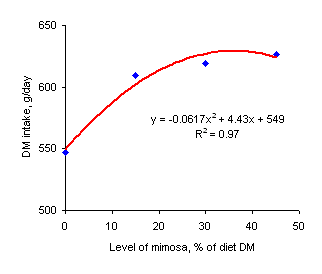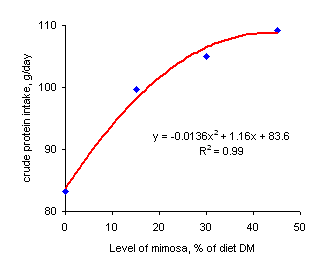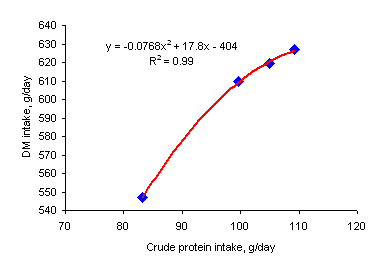| Workshop-seminar, 23-25 May, 2005, MEKARN-CTU |
| Contents |
Feeding value of Mimosa pigra L. for goats
Nguyen Thi Thu Hong and Vo Ai
Quac*
Department of Animal Husbandry & Veterinary,
Angiang University, Vietnam
* Agriculture and Fisheries
Export - Import Company (AFIEX),
1234/63 Tran Hung Dao, Long Xuyen,
An Giang, Vietnam.
Abstract
A study was carried out at An Giang University from April to
June 2004 to determine the effects of the foliage of a wild legume
bush Mimosa pigra on intake and nutrient digestion of
growing goats. The experiment used four goats, of 11 kg
initial live weight, in a Latin square arrangement of four
treatments with 15 day feeding period. In every
period one goat was assigned to a different treatment diet.
The control diet was composed of Brachiaria mutica
grass. In the diet MP15, 15% of grass dry matter was replaced by
foliage of the legume; in diet MP30, 30% was legume and in diet MP45
it was 45%. DM and total crude protein intake increased with level of
mimosa in the diet. Digestibility of all
nutrients varied between 68% and
73%.
It was concluded that Mimosa pigra foliage
has potential as a protein supplement for growing
goats.
Key words: Goat, Mimosa pigra, Brachiaria mutica,
feed intake, digestibility.
Introduction
Mimosa pigra leaves have a high protein content
of 20 to 23% in DM according to Vearasilp et al (1981a,b). However, there have
been conflicting reports on whether mimosa contains the toxic amino acid mimosine, which could restrict its
use for animals. Vearasilp et al (1981a) reported that
mimosa did not contain mimosine, but in other reports it has been isolated at a
level of about 0.2% of leaf dry weight (Lonsdale et al
1989). It is doubtful that the foliage would be toxic at this level
of mimosine and it is considerably lower than the 8 to 10% of mimosine reported by Everist (1981) in the fodder
legume Leucaena leucocephala (Lam.) de Wit.
When fed to sheep in Thailand at low levels mixed
with para grass (Brachiaria mutica (Forssk.) Stapf.), mimosa
did not reduce digestibility of the feed and was considered as a
high-protein feed component (Vearasilp et al 1981b). In an
experiment comparing the effect of substituting mimosa for leucaena in pig and rat rations, no significant differences were
recorded for average daily gain, feed intake and feed-efficiency
ratios, suggesting that mimosa can substitute completely for
leucaena (Vearasilp et al 1981a).
The objective of this study was to determine whether foliage of Mimosa
pigra as a supplement can satisfy the requirements of goats weighing
10 to 12 kg and growing at 50g/day.
Material and methods
The study was carried out at An Giang University Research Farm,
An Giang province, Vietnam. Four growing goats with an average body
weight of 11 kg and 3-4 months were used. The goats were vaccinated
against foot and mouth disease and de-wormed before the initiation
of the experiment. They were individually fed in metabolism cages
with free access to water.
Four goats were allocated to four treatments according to a 4*4
Latin square design. The four experimental diets had different levels of mimosa
as replacement for para
grass. The control diet was composed of Brachiaria mutica
grass. In the diet 15MP, 15% of grass dry matter was replaced by
that of the legume; in diet 30MP, 30% was legume and in diet 45MP, the
legume was 45%. Experimental periods consisted of 15 days in which samples of
faeces were individually collected from days 11 to 15.
Data recorded were feeds offered and refused. For
further analysis, about 10% of the faeces from each goat was taken
daily and accumulated in a deep freezer at -20oC until
the of the experiment. Feeds, refusals and faeces were analyzed for
DM, CP and ash according to AOAC (1990). NDF and ADF were
determined according to Van Soest and Robertson (1985).
Data on feed intake and digestibility were subjected to analysis
of variance using the least squares General Linear Model (GLM)
procedure of the Minitab statistical Software Release 13.2
(2000).
Results and discussion
The foliage of Mimosa pigra was higher in crude protein and lower in cell wall constituents than the Brachiaria mutica (Table 1).
|
Table 1. Chemical composition of Mimosa pigra and Brachiaria mutica in the experiment |
||
|
|
Mimosa pigra |
Brachiaria mutica |
|
DM g/kg |
360 |
242 |
|
g /kg DM |
||
|
CP |
207 |
129 |
|
OM |
928 |
887 |
|
NDF |
534 |
669 |
|
ADF |
379 |
365 |
Intake if DM and crude protein by the goats increased curvilinearly as the proportion of mimosa foliage in the diet was increased (Table 2 and Figures 1 and 2). on goats fed the Mimosa pigra with similar dry matter intake, reflected a hight and palatable protein of the legume. Apparent digrstinbility coefficients were high on all diets.
|
Table 2: Mean values for feed intake and apparent digestibility coefficients (%) of the experiment diets |
|||||
|
|
Control |
MP15 |
MP30 |
MP45 |
SEM |
|
Feed intake, g/day |
|
|
|
|
|
|
Dry matter |
547 |
610 |
620 |
627 |
26.9 |
|
Crude protein |
83.2 |
99.6 |
105 |
109.2 |
3.8 |
|
Organic matter |
487 |
548 |
560 |
567 |
23.4 |
|
Apparent digestibility (%) |
|||||
|
Dry matter |
69.8 |
69 |
75.4 |
72.9 |
2.9 |
|
Crude protein |
70.0 |
68.5 |
73.7 |
70.3 |
3.2 |
|
Organic matter |
71.3 |
70 |
76.1 |
77.5 |
3.1 |
|
ADF |
68.6 |
56.4 |
64.6 |
65.6 |
4.2 |
|
NDF |
71.8 |
68.5 |
74.0 |
75.6 |
2.9 |
 |
 |
|
|
Figure 1: Effect on DM intake of
supplementing para grass |
Figure 2: Effect on crude protein intake of
supplementing para grass with mimosa foliage |
Protein intake appeared to be the major determinant of DM intake as there was a close relationship between the two variables (Figure 3). The importance of protein intake as the determinant of performance in ruminant has been strongly emphasized by Preston and Leng (1987).

Figure 3: Relationship between intake of crude protein and DM intake for goats fed para grass and mimosa foliage
.
Conclusions
Mimosa pigra appears to be a promising source of protein-rich foliage which is well accepted by goats.
References
AOAC 1990
Official Methods of Analysis,
15th editon. Association of the Official Analytical
Chemists, Washington D.C.
Minitab, 2000.minitab Reference Manual, Release 13.1 for
Windows. Minitab Inc., USA.
Van Soest P J and Robertson J
B 1985 Analysis of forages and fibre foods. A Laboratory Manual for Animal
Science 613. Department of Animal Science. Cornell University.
Ithaca, New York.
Vearasilp T, Phuagphong B and Ruengpaibul S
1981a A comparison of Leucaena leucocephala and
Mimosa pigra L. in pig diets. Thai Journal of
Agricultural Science, 14, 311-317.
Vearasilp T, Potikanond N and Rajja-Apai P 1981b Mimosa pigra in sheep rations. Thai Journal of Agricultural Science, 14, 59-64.